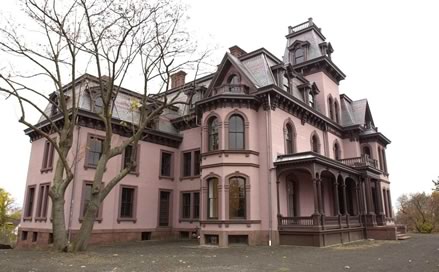
New York architects are transforming residence into a global studies center

Associate Editor
The façade and French Second Empire design may suggest a haunted house, but to Yale University and Helpern Architects, New York City, the John M. Davies Mansion on a hilltop on Prospect Street in New Haven was an architectural treasure perfect for two new programs that will help solidify the university's place on the international stage.
Yale chose Helpern to renovate the interior of the derelict mansion and turn it into the home of two new major programs on international affairs: the Yale Center for the Study of Globalization and the Yale World Fellows program. Strobe Talbott, former deputy secretary of state, ambassador, scholar, and a 1968 graduate of Yale College, directs the Center for Study of Globalization. Brooke Shearer, former director of the President's Commission on White House Fellows from 1993 to 1997, is the executive director of the Yale World Fellows Program, and Yale faculty member and environmental law and policy expert Daniel C. Esty, is the program's director.
"As part of the celebration of its 300th anniversary,
Yale is looking to expand its already significant role on the world stage,"
said architect David Paul Helpern, FAIA. "The University is building
for this future by rescuing an impressive piece of the past at the Davies
Mansion."
Long pedigree
New Haven architect Henry Austin designed the now 133-year-old, four-story
structure for John M. Davies, who was associated with the Winchester Repeating
Arms Company and the Winchester family, of Winchester Mystery House (San
Jose, Calif.) fame. First owned by Davies, the mansion went through a
series of owners, and was subsequently purchased by the Culinary Institute
of America (the other CIA) in 1948 and was known as Angell Hall. When
the CIA moved to Hyde Park, N.Y., in 1972, Yale bought the property and
left it vacant.

After its transfer to Yale, the 23-room mansion,
which is on the National Register of Historic Places, fell victim to fire
and vandalism. Its preservation and restoration, along with that of five
other historic homes on the university campus, was discussed during the
ensuing years. The school worked with the New Haven Preservation Trust
and other interested parties to preserve the mansion, along with four
other of the six historic houses. As part of an agreement on the fate
of the six homes, the university fully rehabilitated the exterior and
restored one of the parlors of the Davies Mansion in 1999.
Recently, the Davies Mansion received a $5 million donation from Yale
Corporation member Roland W. Betts, and his wife Lois Phifer Betts. The
home will be renamed in honor of the Betts' family, which boasts five
generations of Yale graduates among its ranks.
Now a major interior renovation is under way, and the project is slated for completion by the fall of 2002. Work on the Davies Mansion has included asbestos removal, interior demolition, and structural stabilization.
"What's in the
spirit?"
The challenge and opportunity is being sensitive to the character of the
original design, said Margaret Castillo, AIA, a Helpern principal. She
said the firm has extensively researched the Davies Mansion and other
historic properties they have worked on at Yale. For example, for several
of the homes they have found original photos and have researched architects'
diaries at libraries and museums. They have also used historic renovation
techniques such as paint analysis. For the Davies Mansion Helpern Architects
gathered enough materials from the Yale archives, New Haven Colony Historical
Society, and the Library of Congress Web site to make educated choices
about the direction the designs should take.
"Not in all cases can you recreate what was there," Castillo said. She continued that it is a subjective process that raises the question "What's in the spirit?" of the original structure.
Building in flexibility
Castillo said the new infrastructure would reflect the building's modern
uses while building in flexibility. The plans call for the delicate restoration
and replication of elaborate plaster moldings. The architects are working
to preserve the spaces that are there by being sensitive about the placement
of new stairs, elevators, and restrooms. They also plan to maintain the
shape of the rooms on the first floor despite these new additions.
The new building will also feature administrative offices, meeting rooms, a lounge, a central hall with grand stairs, a publications and Web site office, conference center, and library. It will also be furnished with videoconferencing and audiovisual equipment and new mechanical, electrical, fire protection, and security systems.
Castillo noted that the Davies effort is the firm's fourth renovation of historic 19th century houses at Yale, following projects at the Skinner-Trowbridge, Perit, and Apthorp houses.
Copyright 2001 The American Institute of Architects. All rights reserved.
![]()
|
The interior renovation of the Davies Mansion is Helpern Architect's fourth renovation of notable 19th-century houses at Yale. The mansion will house two new programs, the Yale Center for the Study of Globalization and the Yale World Fellows Program. |
|